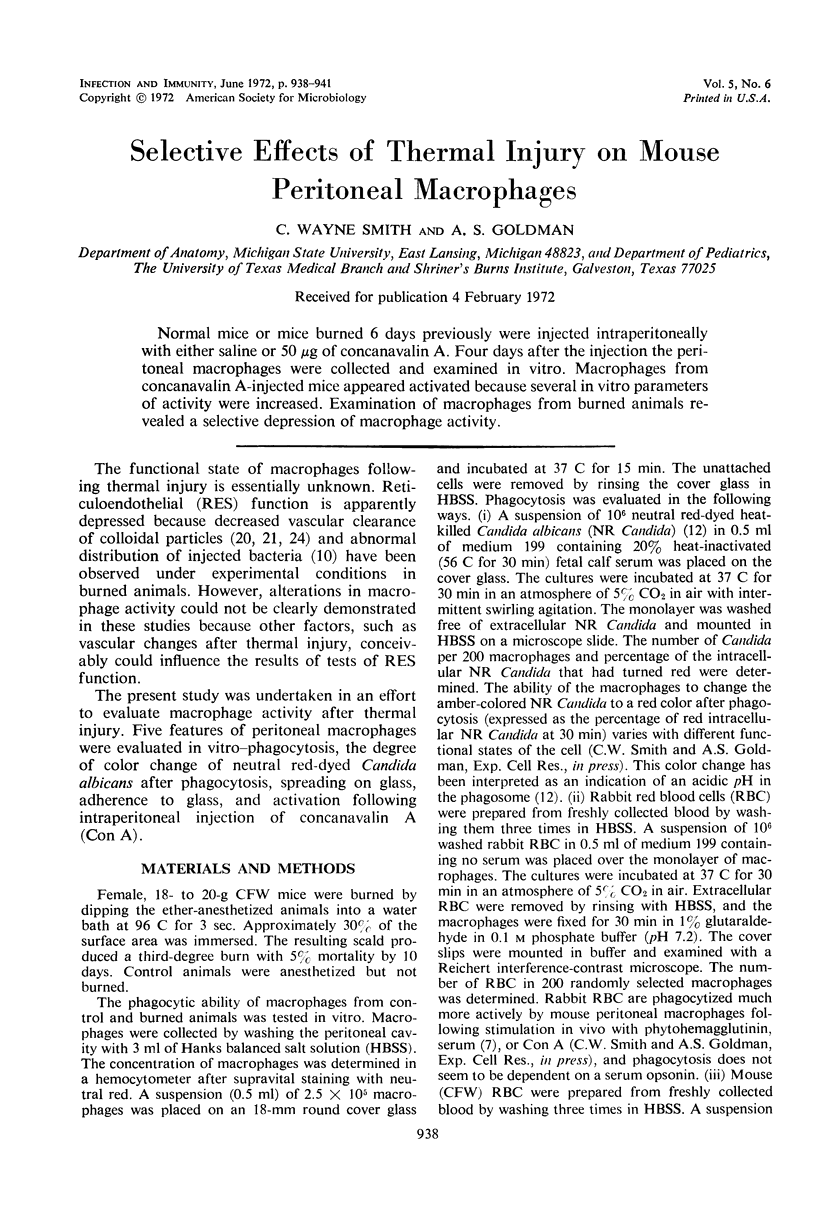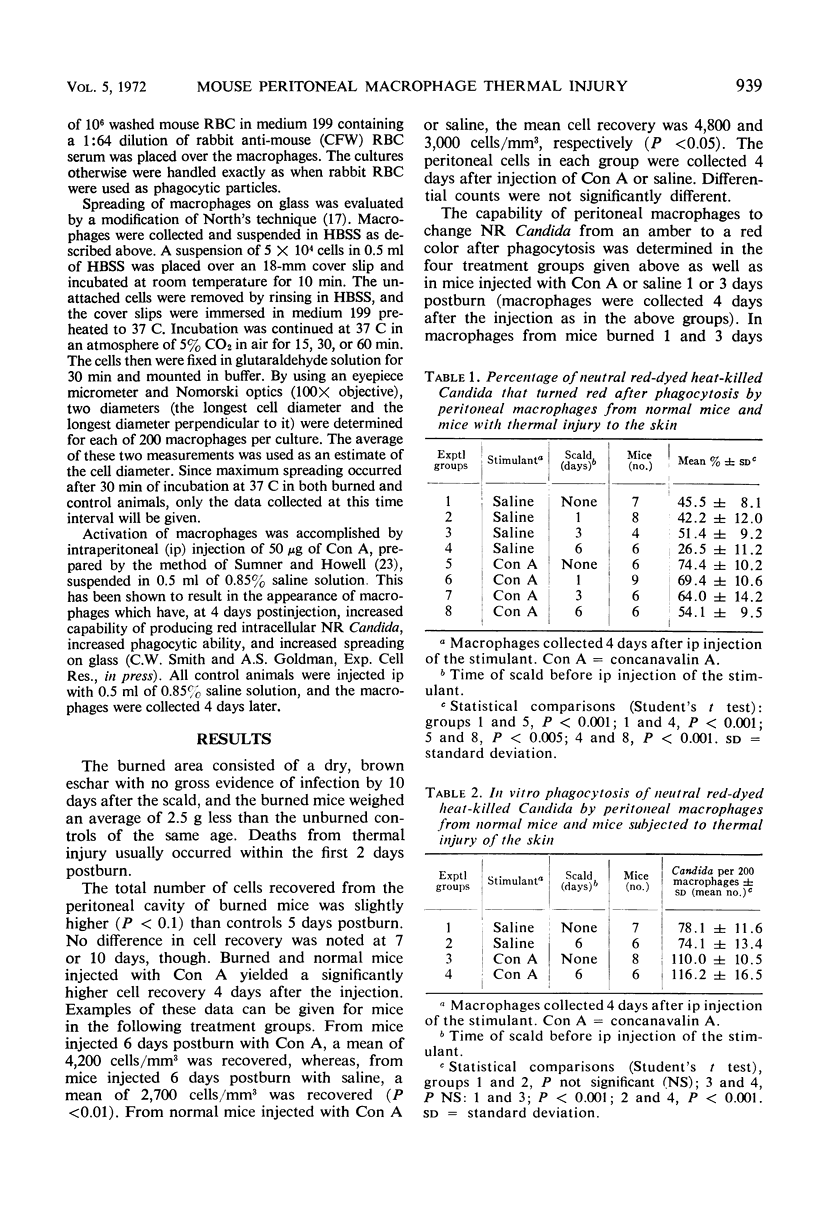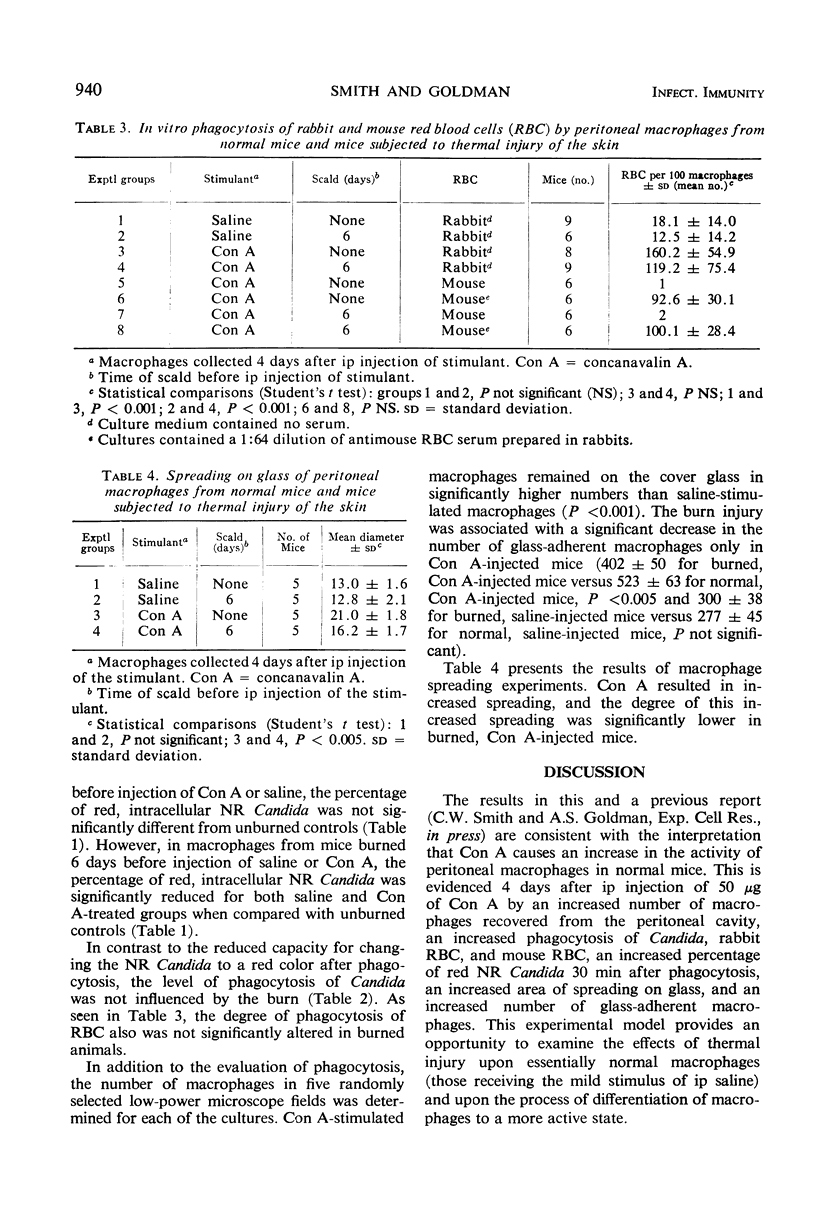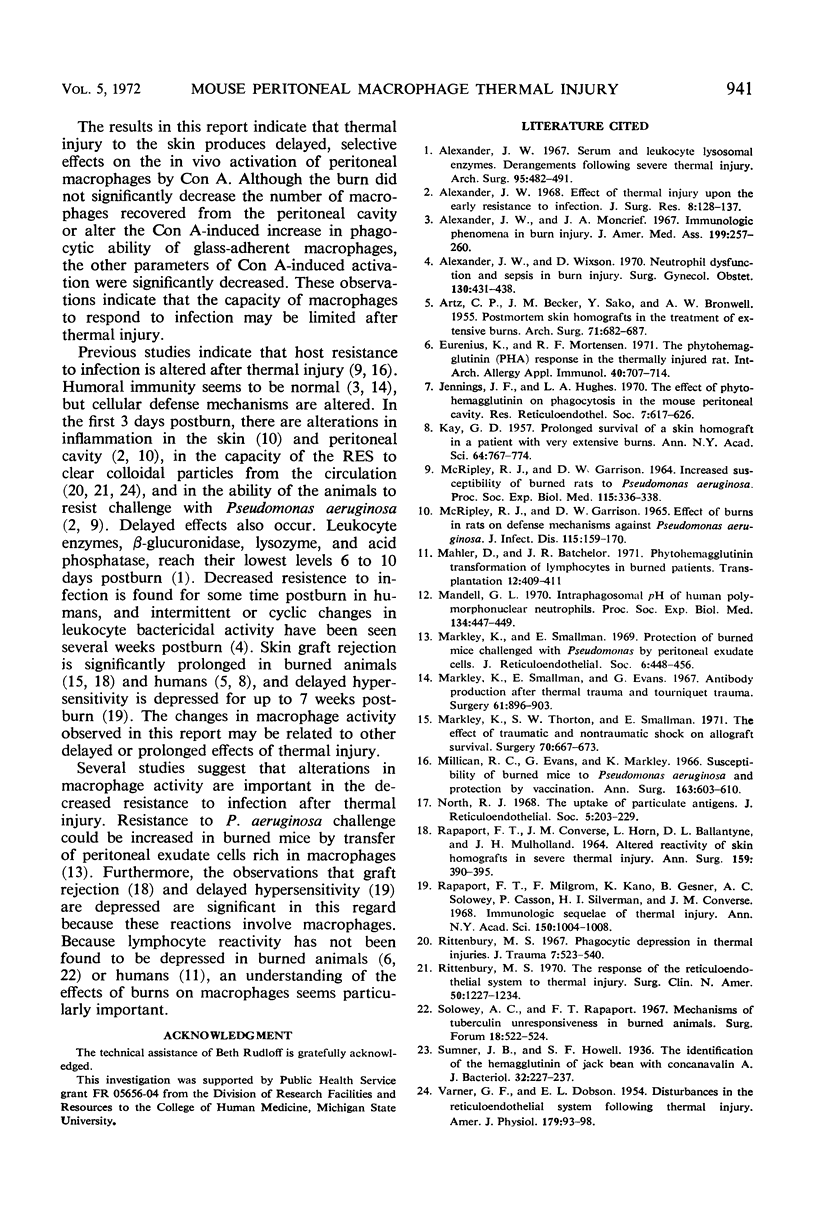Abstract
Normal mice or mice burned 6 days previously were injected intraperitoneally with either saline or 50 μg of concanavalin A. Four days after the injection the peritoneal macrophages were collected and examined in vitro. Macrophages from concanavalin A-injected mice appeared activated because several in vitro parameters of activity were increased. Examination of macrophages from burned animals revealed a selective depression of macrophage activity.
Full text
PDF



Selected References
These references are in PubMed. This may not be the complete list of references from this article.
- ARTZ C. P., BECKER J. M., SAKO Y., BRONWELL A. W. Postmortem skin homografts in the treatment of extensive burns. AMA Arch Surg. 1955 Nov;71(5):682–687. doi: 10.1001/archsurg.1955.01270170040006. [DOI] [PubMed] [Google Scholar]
- Alexander J. W. Effect of thermal injury upon the early resistance to infection. J Surg Res. 1968 Mar;8(3):128–137. doi: 10.1016/0022-4804(68)90074-7. [DOI] [PubMed] [Google Scholar]
- Alexander J. W., Moncrief J. A. Immunologic phenomena in burn injuries. JAMA. 1967 Jan 23;199(4):257–260. [PubMed] [Google Scholar]
- Alexander J. W. Serum and leukocyte lysosomal enzymes. Derangements following severe thermal injury. Arch Surg. 1967 Sep;95(3):482–491. doi: 10.1001/archsurg.1967.01330150158020. [DOI] [PubMed] [Google Scholar]
- Alexander J. W., Wixson D. Neutrophil dysfunction and sepsis in burn injury. Surg Gynecol Obstet. 1970 Mar;130(3):431–438. [PubMed] [Google Scholar]
- Eurenius K., Mortensen R. F. The phytohemagglutinin (PHA) response in the thermally injured rat. Int Arch Allergy Appl Immunol. 1971;40(4-5):707–718. doi: 10.1159/000230453. [DOI] [PubMed] [Google Scholar]
- Jennings J. F., Hughes L. A. The effect of phytohemagglutinin on phagocytosis in the mouse peritoneal cavity. J Reticuloendothel Soc. 1970 May;7(5):617–626. [PubMed] [Google Scholar]
- KAY G. D. Prolonged survival of a skin homograft in a patient with very extensive burns. Ann N Y Acad Sci. 1957 Mar 22;64(5):767–774. doi: 10.1111/j.1749-6632.1957.tb52471.x. [DOI] [PubMed] [Google Scholar]
- MCRIPLEY R. J., GARRISON D. W. EFFECT OF BURNS IN RATS ON DEFENSE MECHANISMS AGAINST PSEUDOMONAS AERUGINOSA. J Infect Dis. 1965 Apr;115:159–170. doi: 10.1093/infdis/115.2.159. [DOI] [PubMed] [Google Scholar]
- MCRIPLEY R. J., GARRISON D. W. INCREASED SUSCEPTIBILITY OF BURNED RATS TO PSEUDOMONAS AERUGINOSA. Proc Soc Exp Biol Med. 1964 Feb;115:336–338. doi: 10.3181/00379727-115-28906. [DOI] [PubMed] [Google Scholar]
- Mahler D., Batchelor J. R. Phytohaemagglutinin transformation of lymphocytes in burned patients. Transplantation. 1971 Nov;12(5):409–411. doi: 10.1097/00007890-197111000-00015. [DOI] [PubMed] [Google Scholar]
- Mandell G. L. Intraphagosomal pH of human polymorphonuclear neutrophils. Proc Soc Exp Biol Med. 1970 Jun;134(2):447–449. doi: 10.3181/00379727-134-34810. [DOI] [PubMed] [Google Scholar]
- Markley K., Smallman E., Evans G. Antibody production in mice after thermal and tourniquet trauma. Surgery. 1967 Jun;61(6):896–903. [PubMed] [Google Scholar]
- Markley K., Smallman E. Protection of burned mice challenged with pseudomonas by peritoneal exudate cells. J Reticuloendothel Soc. 1969 Oct-Dec;6(5):448–456. [PubMed] [Google Scholar]
- Markley K., Thornton S. W., Smallman E. The effect of traumatic and nontraumatic shock on allograft survival. Surgery. 1971 Nov;70(5):667–673. [PubMed] [Google Scholar]
- Millican R. C., Evans G., Markley K. Susceptibility of burned mice to Pseudomonas aeruginosa and protection by vaccination. Ann Surg. 1966 Apr;163(4):603–610. doi: 10.1097/00000658-196604000-00014. [DOI] [PMC free article] [PubMed] [Google Scholar]
- North R. J. The uptake of particulate antigens. J Reticuloendothel Soc. 1968 Jun;5(3):203–229. [PubMed] [Google Scholar]
- RAPAPORT F. T., CONVERSE J. M., HORN L., BALLANTYNE D. L., Jr, MULHOLLAND J. H. ALTERED REACTIVITY OF SKIN HOMOGRAFTS IN SEVERE THERMAL INJURY. Ann Surg. 1964 Mar;159:390–395. doi: 10.1097/00000658-196403000-00010. [DOI] [PMC free article] [PubMed] [Google Scholar]
- Rapaport F. T., Milgrom F., Kano K., Gesner B., Solowey A. C., Casson P., Silverman H. I., Converse J. M. Immunologic sequelae of thermal injury. Ann N Y Acad Sci. 1968 Aug 14;150(3):1004–1008. doi: 10.1111/j.1749-6632.1968.tb14753.x. [DOI] [PubMed] [Google Scholar]
- Rittenbury M. S., Hanback L. D. Phagocytic depression in thermal injuries. J Trauma. 1967 Jul;7(4):523–540. doi: 10.1097/00005373-196707000-00004. [DOI] [PubMed] [Google Scholar]
- Rittenbury M. S. The response of the reticuloendothelial system to thermal injury. Surg Clin North Am. 1970 Dec;50(6):1227–1234. doi: 10.1016/s0039-6109(16)39283-0. [DOI] [PubMed] [Google Scholar]
- Sumner J. B., Howell S. F. Identification of Hemagglutinin of Jack Bean with Concanavalin A. J Bacteriol. 1936 Aug;32(2):227–237. doi: 10.1128/jb.32.2.227-237.1936. [DOI] [PMC free article] [PubMed] [Google Scholar]
- WARNER G. F., DOBSON E. L. Disturbances in the reticulo-endothelial system following thermal injury. Am J Physiol. 1954 Oct;179(1):93–98. doi: 10.1152/ajplegacy.1954.179.1.93. [DOI] [PubMed] [Google Scholar]


